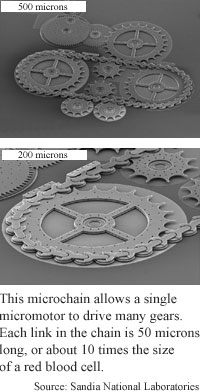
Tiny
chain revs microdevices
By
Chhavi Sachdev,
Technology Research NewsOne gear in a mechanical wristwatch trips another that sets in motion yet another, and it all happens in a fairly small space. A researcher at Sandia National Laboratories has come up with a tiny silicon chain that gets many much smaller gears going at once in a much smaller space.
The tiny chain system resides on a computer chip, measures a single millimeter from end to end, and works like a bicycle chain. Each of its 50 links is 50 microns long, or about ten times the size of a red blood cell. As a link moves, it catches on a gear tooth, which turns the gear.
The advantage of using a chain to move or rotate parts is that the parts do not have to be close to the motor that drives the motion. A single silicon chain can also drive several components in different locations on a chip.
The idea for the chain came because the motors in Sandia's microscopic shutter and gear mechanisms take up a lot of space, said Ed Vernon, a design engineer at Sandia. "Currently our micro-engines can take up to a third of the allotted real estate. I thought that if I could drive multiple devices with a single engine more of the real estate could be used for mechanical devices," he said.
Small chain systems are currently used in camera shutters and small machines. "Microchains could have as many applications as conventional chains as this technology progresses... the earliest applications might come in the bio-medical area," said Vernon.
Each link can rotate plus or minus 52 degrees with respect to the link preceding it. Since the joint between any two links is able to swivel more than 90 degrees, "very sharp turns are possible as well as complex threaded systems," Vernon said.
The prototype is 2.5 millimeters long but could be extended with the help of a chain tensioner. "Chain systems are typically designed with slack in them," said Vernon. A tensioner takes up the slack after it starts moving and provides slack during high-torque starts.
The silicon chain is fabricated much like an integrated circuit, said Vernon. He used alternating layers of doped silicon and oxide, then etched away parts of the material to make the chain.
The machining challenge was in making a floating, unanchored device, said Vernon. All the sprockets of the gears in this design are anchored to a silicon wafer, but the links of the chain are not. "It is not common for devices to be free of the substrate in surface micromachining," he said.
The work is remarkable, said Bruce R. Donald, a professor of computer science and chemistry at Dartmouth College. "It is a technological tour de force [and opens] up a wide range of new capabilities," he said.
The microchains could be used in many different kinds of dynamic micromachines, Donald said. Applications could include micromachines that manufacture tiny parts; a way of signing a document mechanically rather than electronically for better security; and a closer study of the structure of molecules like proteins, he said.
The chains could also be used in the field of biotechnology, "to make implantable mechical devices for numerous applications," said Vernon. "It is not too much of a stretch to imagine this chain as a tiny chain saw. If you incorporate a vacuum, tumor removal could be very precise."
Sandia is in the process of licensing this technology to the public sector, said Vernon. "If the technology is successful in the public sector there could be a need for the chain within 2 to 3 years." For now, the lab is planning to improve the reliability and packaging of the chains, he said.
The work was funded by the Department of Energy.
Timeline: 2-3 years
Funding: Government
TRN Categories: Microelectromechanical Systems (MEMS)
Story Type: News
Related Elements: Technical paper, "Surface Micromachined Chain," presented at the "Workshop on Microsystems Technology & Applications," July, 2001.
Advertisements:
February 6, 2002
Page One
Tiny chain revs microdevices
Labs-on-a-chip gain micro mixer
Starting over speeds searches
Nudged nested nanotubes may oscillate
Portfolios boost quantum computing

News:
Research News Roundup
Research Watch blog
Features:
View from the High Ground Q&A
How It Works
RSS Feeds:
News
Ad links:
Buy an ad link
| Advertisements:
|
 |
Ad links: Clear History
Buy an ad link
|
TRN
Newswire and Headline Feeds for Web sites
|
© Copyright Technology Research News, LLC 2000-2006. All rights reserved.